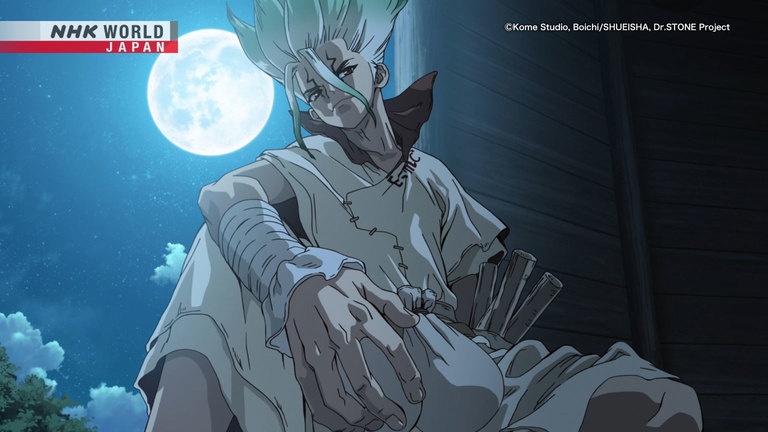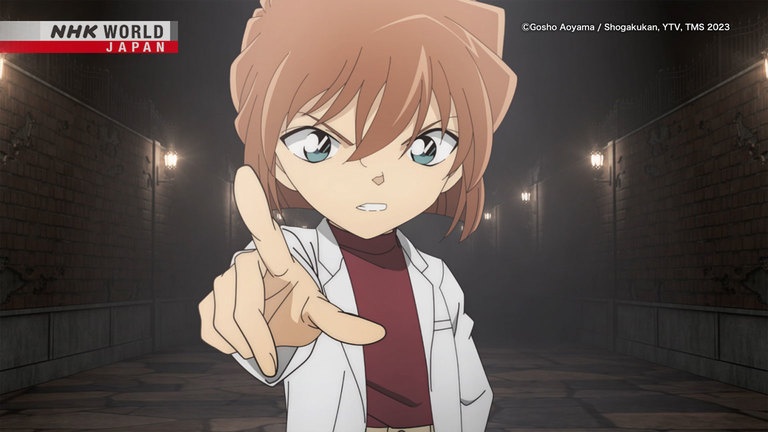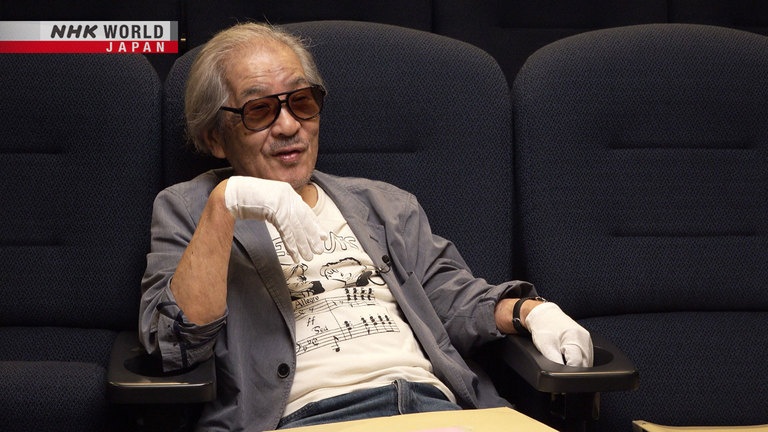THE ANIME STUDIO: TMS ENTERTAINMENT
ANIME MANGA EXPLOSION dives into the world of Japanese anime and manga, both of which have gained immense global followings. In this episode, we're featuring TMS ENTERTAINMENT, a long-established studio celebrating its 60th anniversary in 2024. Known for beloved hits like Lupin the 3rd, Detective Conan and Dr.STONE, the veteran studio shares its secrets behind anime creation as well as a special look at some initiatives the studio is undertaking to promote sustainability in the Japanese anime industry.




Transcript
ANIME MANGA EXPLOSION.
If it has rules, it's science.
And if it's a science battle, we can't lose.
Now, let's get crackin'.
More and more anime like these are being released worldwide.
The studio behind these two hits is TMS Entertainment.
Founded in 1964, the veteran anime studio has released 100s of anime.
TMS continues to be a pioneering force in Japanese anime.
Over the generations, TMS' pursuit of realism has remained the same.
Their focus on detail is easy to see.
TMS is also leading the anime industry's shift to digital production, tackling the lack of talent head-on.
This is all in addition to their goal of improving studio profitability industry-wide.
We want to uproot
the traditional structure,
and make sure anime studios
profit from hits.
This time, we're going behind the scenes of Japan's anime pioneer, TMS Entertainment!
TMS has maintained a steady profit for years by creating anime based on popular series.
His name is Edogawa Conan.
A smart elementary student.
The "Detective Conan" series began in 1996, with new TV series and films released yearly.
Betrayal is like an accessory to women.
"Lupin the 3rd" was a rare mature anime about a group of thieves and has remained popular for over 50 years.
TMS also works on Japan's classic children's series "Anpanman."
Their hits span a variety of genres.
The work environment has also developed over the years.
Color is applied in the coloring room.
Lighting and effects are added in the compositing room.
There're also editing rooms
and a theater room for previews.
Well-equipped facilities and years of know-how are crucial to TMS' vision.
At TMS, we mainly work on
story-based anime.
Storytelling has been
a big part of our legacy.
The Literature Department employs staff
who specialize in storytelling.
It's another strength of TMS.
This archive is full of past TMS anime series.
This includes scripts, storyboards, and other materials.
These are cel drawings from "Star of the Giants," a landmark Japanese sports anime from 1968.
At the time, anime used cel animation, with each page drawn by hand.
You have to wait
for each color to dry.
The larger the area,
the more time it took.
It was a very laborious process.
Coloring, which now uses digital tools, was done by hand, adding considerable time to the process.
This is from one of TMS' flagship works.
The proposal for "Lupin the 3rd Part 1."
Broadcast on Japanese TV in 1971, it was a rare anime made for mature audiences.
The story follows Lupin the 3rd, the grandson of thief Arsene Lupin,
and his friends traveling around the world searching for treasure.
Billed as an anime for adults, "Lupin the 3rd" featured flirty exchanges between characters and realistic gun fights.
That was pretty good acting, Fujiko.
We got to talk with Osumi Masaaki, the 89-year-old legend who directed "Lupin the 3rd Part 1."
Osumi has a background in puppet theater and worked on numerous classics from the early days of TV animation.
The proposal for "Lupin the 3rd Part 1" included this illustration.
The image is packed with the staff's enthusiasm to create a genuine adult-oriented anime.
"Film at a desert location
or research documentary films."
Networks seemed to like the proposal.
We needed an illustration
that was clearly adult-oriented.
It needed to feel mature
to anyone who saw it.
In 1964, Osumi helped found Tokyo Movie, the predecessor of TMS.
However, the new studio quickly ran into problems.
There weren't many animators
in Japan in the 1960s.
Outside of Toei Animation, there were
zero animators that made TV anime.
Tokyo Movie was an anime studio
without a single animator.
In the 1960s, TV networks had only just begun to broadcast animation.
Animators were in short supply, so there were limits to frame counts.
Osumi and his colleagues set up a production department
to research ways of expressing realistic movement within those limitations.
We couldn't create anime
that used a lot of cels.
In the department, directors searched
for ways to best use that limit.
Basically, we looked for still images
that contained realistic movement.
Their research led to natural movements that used only a few frames.
Professionals are relaxed
until the last second.
It looks professional when a relaxed
character quickly gets into position.
Relaxed poses don't need much movement.
A still image is all we needed.
Osumi created the movement of a professional by mixing still imagery and fast action.
The password for "Ha" is... This!
Lupin the 3rd's relaxed, lethargic demeanor became one of his most recognizable traits.
Characters lean against walls
or have a hand in a pocket.
Their poses are rarely symmetrical.
A pro can quickly get into action.
We spent a lot of time
discussing that part.
For Lupin's partner, Jigen Daisuke, the focus was on how he uses his gun.
Just for Jigen, we added a cel
to his shoulder movement.
Adding a single frame
makes it look professional.
Everything else but the shoulder
is stationary.
That was such a fun discovery.
Another characteristic of "Lupin the 3rd" is its pursuit of reality.
The production team abandoned fictitious designs and went with realistic vehicles and guns.
This is a sketch of a car featured in "Lupin the 3rd Part 1."
Detailed instructions help animators maintain the vehicle's realistic look.
"With wheels, the trick is to draw the tires
hidden from view. Be careful of car height."
Otsuka Yasuo prepared this illustration.
The veteran has been around since the early days of Japanese animation.
A creator like Otsuka
is hard to come by.
He was the only animator you
could talk to as he worked.
One time, I mentioned a movie
I had snuck out to see the day before.
As he drew, he replied, "I saw it too."
Then, on another paper,
he drew a scene from the movie.
"Remember this part?"
Then he went back to work.
Otsuka, now part of the team, added a sense of realism to "Lupin the 3rd."
Take Pycal's car in episode two.
It's the only car made by Messerschmitt,
German fighter aircraft maker.
I told Otsuka,
"Let's put Pycal in a Messerschmitt!"
His eyes lit up.
"Great idea!
That's perfect for the character!"
After that, we chose vehicles
and weapons that fit each character.
Otsuka talked about how a few samples
of the Mercedes-Benz SSK still existed.
Lupin drives a custom Mercedes-Benz SSK.
The realistic imagery found in "Lupin the 3rd" greatly impacted the future of anime.
There have been six "Lupin the 3rd" films, six TV series,
and 27 TV specials, in addition to multiple OVAs and spin-offs.
Well, I couldn't help but feel kinda bad
seeing you go out like this. Get in.
For me, TMS is where everything started.
I don't know how TMS feels about me,
but I consider the studio my home.
We caught a meeting of staff members reading manga.
This is a script meeting for the latest entry in the "Dr. STONE" series.
The director, screenwriter, producer, other staff and publisher representatives carefully review scripts.
"Dr. STONE" originated as a popular manga with 15 million copies sold.
In the post-apocalyptic story, a mysterious phenomenon has turned people to stone.
Senku, revived from petrification, helps civilization restore itself from scratch.
Holy crap, it's freaking fast!
TMS began production on the series in 2019.
Season three aired in 2023.
Matsushita Shuhei directed season three of "Dr. STONE."
When everything is fake,
anything is possible.
Same with magic.
But science is vital in "Dr. STONE,"
so I want to protect that aspect.
Realism was also a major goal for the production team.
Senku's ability to create various inventions by hand is a big draw of the series.
Inventions include vehicles like ships and balloons,
as well as products from civilization like cell phones and cameras.
With a strong focus on science, the team holds detailed discussions about Senku's inventions.
Leading this meeting is Mizumura Yoshio, who is in charge of mecha and prop art.
With over 40 years of experience,
Mizumura's mechanical and vehicular designs are considered some of the industry's best.
Mizumura takes ideas from the meeting and plans out how to put them on the page.
Guns need maintenance
after a few shots.
I think the bullets
are too big for the gun.
Mizumura has been responsible for "Dr. STONE"'s designs since season one, drawing over 120 pieces.
Anime is made by a group of people.
The process falls apart
without benchmarks.
Having well-conceived designs
improves the overall quality.
I try to draw angles and sizes
that are easy for animators to follow.
Season three features a drone prototype.
The original work has this striking image, but it needs to be moving in an anime.
Mizumura's drone design looks like an instruction manual.
Propellors use four feathers.
The side view shows bearings, pulleys, the frame, and other parts with detailed information.
Twisting the belt around
would waste energy.
It wouldn't be able to fly.
I tried to keep it
as horizontal as possible.
Here's the drone scene in action.
I imagine how unnecessary force
could make it stop working or break it.
My intention is to create machines
that work beautifully.
Mizumura's designs are a big part of "Dr. STONE"'s concept art.
It's like I rediscover how something
is put together and how things work.
I get a lot of great insights.
The team was very surprised by the loom design for the TV special "Dr. STONE Ryusui."
After attending a hands-on weaving workshop to study the structure of a real loom, Mizumura created three designs.
Even though Mizushima worked long and hard on its design, the loom only appears for 10 seconds.
As I draw, things naturally
escalate inside of me.
There are times I completely forget
how many cuts there are.
TMS is taking on new initiatives to shape the anime industry's future.
This digital drawing workshop is aimed at freelance animators who want to move from analog to digital animation.
The workshop is free of charge.
TMS also provides financial subsidies for animators who lose work by attending class.
Animators of all ages, from newcomers to veterans, have joined.
TMS's CEO explained the importance of shifting to digital.
As anime grows in popularity,
so does the demand to create more.
But every studio lacks animators.
There just aren't enough available.
Hiring new animators
is an industry-wide problem.
We have no choice
but to change the creation process.
Digital drawing tools let animators work more efficiently with image duplication, material importing, and library access.
Going paperless will also reduce transportation and storage costs.
For the "Anpanman" team, the goal is
to go completely paperless.
Draw, review, and finalize
using only digital tools.
TMS is also developing digital tools to compensate for the animator shortage.
TMS and its affiliated companies use 2D animation software to collaborate on anime projects.
One of the best parts of Japanese anime
is the unique artistic expression.
I want to use technology
while preserving what makes
Japanese anime so attractive.
For this process, animators first import original drawings.
Then, the drawings are split into parts and used in the software to create movement.
Even without drawing each image individually, animation can be made
by digitally adjusting facial expressions, hand movements, and clothing.
Everything, including the eyes, can be
divided into parts and moved around.
You can adjust where a character looks
and add actions like blinking.
It's easy to make detailed adjustments.
TMS is proving studios can take advantage of technology while maintaining a hand-drawn feel.
Only a veteran like TMS could take on challenges like these.
One crucial aspect
is the delicate line work.
Digital lines need to be of a quality
that doesn't bother regular viewers.
The technology is already being put to use, as seen in the opening for this "Detective Conan" special.
Rest assured,
I've rewritten your data to "confirmed dead."
Your introduction is quite long.
There is only one truth!
TMS generates significant revenue from both producing anime and selling completed works.
There are only a few studios in Japan that can do this.
Currently, Japanese anime is created under a production committee system.
Investing companies split productions costs and share rights and profits among each other.
However, Japanese anime studios with limited financial resources are unable to invest.
Instead, they are hired by production committees, which has detrimental effects.
The combination of investors,
who keep costs as low as possible,
and anime studios, who want to make
the best product within the limits,
means anime studios
would never be profitable.
TMS has been strengthening its sales division for the past eight years.
Besides contract work, they also promote active participation in production committees.
Becoming a committee member gives the studio the right to do animation business.
The diverse business includes selling broadcasting rights to various media, goods, and game rights.
Profits are shared among investing companies.
Each sales representative
receives a commission.
If TMS has the international sales rights,
we try to find buyers around the world.
TMS gets a percentage
of the sales amount.
In 2021, TMS embarked on a new challenge, taking advantage of all the studios learned.
UNLIMITED PRODUCE by TMS.
TMS will lead planning, advertising, and fundraising, while outside studios will produce the anime.
When TMS achieves its business target, a portion of the profits are shared with the outside studio.
It wasn't right for production companies
to be left out of the profit scheme.
We want to change that.
That's why we're creating a completely
different business structure.
When a hit is made,
studios will receive profits, too.
The project birthed "UNDEAD UNLUCK," which began airing in the fall of 2023.
Fuko, an unlucky young girl, meets Andy, an undead boy who can never die.
The story follows their search for the perfect death.
The anime is based on a manga from "Shonen Jump," the magazine home to hits like "Demon Slayer" and "Jujutsu Kaisen."
This is the first time for TMS to produce with a Jump manga.
TMS approached David Production, a studio skilled in action, to partner on this project.
The goal was to create something that would benefit both TMS and David Production.
David production makes
the best action scenes.
They enhance the brand power
of UNLIMITED PRODUCE.
We want to make sure profits
return to our partners.
As Japanese anime grows in popularity worldwide, TMS aims to make the industry sustainable.
I want our company to make significant
contributions to the future of anime.
Not only for our own company, but for
the entire industry's sustainability.
As long as Japanese anime
continue to be produced,
they will continue to be discovered
across the globe.
I want to keep working toward that goal.
TMS has been creating animation for over 60 years.
Supported by the techniques and ideas birthed by their predecessors,
TMS will continue to shape the future of Japanese anime.